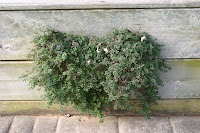

Our small fountain is pretty but the I'm sure the pump is toast.


And lastly, the contorted filbert (Corylus avellana 'Harry Lauder') is really showing off at this time of the year.
Pulaski County Kentucky's home gardening blog!




 This is the cashew tree (bad picture, taken from a moving boat)
This is the cashew tree (bad picture, taken from a moving boat) Here's the wine bottle (I was pleasantly surprised by the taste!)
Here's the wine bottle (I was pleasantly surprised by the taste!)

























 The potatoes have been interesting to watch -- the Square Foot Gardening book (by Mel Bartholomew) says to plant 4 potatoes per square (12" x 12"). I barely covered them at first, then as they grew, I piled more and more soil mix/compost around them.There are 3 different varieties of fingerlings in this 4 x 4. It's weird how different potato plants can look.
The potatoes have been interesting to watch -- the Square Foot Gardening book (by Mel Bartholomew) says to plant 4 potatoes per square (12" x 12"). I barely covered them at first, then as they grew, I piled more and more soil mix/compost around them.There are 3 different varieties of fingerlings in this 4 x 4. It's weird how different potato plants can look.





 organic matter to the bed. Not is all lost.
organic matter to the bed. Not is all lost.

